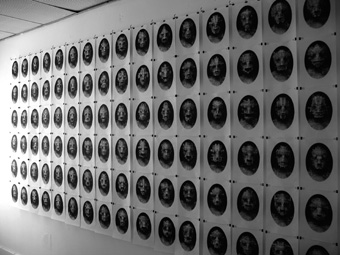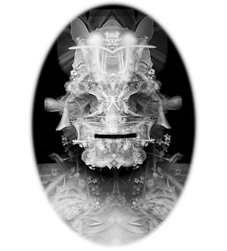monstrous beauty
ashley crawford face to face with pzombies and mortality

Murray McKeich, pzombie installation
photo Jonathan Rann
Murray McKeich, pzombie installation
THE SMALL, HIDDEN-AWAY ROOM IN MELBOURNE’S CBD HAS SOMETHING OF THE AIR OF A FORENSICS LAB. FACES, LIKE RETRO-FUTURISTIC MUG-SHOTS, ADORN THE MAIN WALL. AT FIRST THIS IS SUGGESTIVE OF THE REPLICATION OF THE SAME IMAGE—UNTIL THE INDIVIDUAL PATHOLOGY OF THE SUBJECT’S PHYSIOLOGY BECOMES UNNERVINGLY APPARENT.
Murray McKeich has been using computer technology for many years to create his macabre imagery. But it has none of the high-gloss or hi-tech aesthetics that so often characterises such work. Indeed, McKeich’s approach suggests the opposite; it is in his abuse of technology that the potency emerges.
For all of the cool, medical-examination style of installation, what creates the grit in these works is McKeich’s materials. He uses rubbish as his source material; all sorts of rotting, stinking, putrid crap oozing all over his state-of-the-art technology. When he scans his detritus it may clear away the smell, but not the hint of malevolent, maggot-ridden rot.
McKeich titled this body of work pzombie. Does this make his zombies postmodern zombies, psychotic zombies (aren’t they all?). Is he investigating the psychology of zombies or, as Kirsten Rann suggests in her accompanying essay, perhaps McKeich is investigating the philosophical “discourse in the field of cognitive science, specifically in relation to human consciousness.”

Murray McKeich, pzombie
The zombie seems to be rampant in popular culture. There are the literal, obvious references in such recent films as 28 Days Later and the remake of Dawn of the Dead. There are hints of zombification in Cormac McCarthy’s recent novel The Road. And I would not be the first to watch news footage of White House press conferences and wonder about a certain individual. The zombie is, in popular culture, the embodiment of evil, a flesh eating and mindless ogre. A pzombie, as Kirsten Rann points out in her catalogue essay, is in fact a real term in discussion of the mind and taking this further into the realm of artificial intelligence—what in fact it means to be conscious.
But McKeich’s pzombies may also be the stunned and stunted results of information overload. They are most certainly, if not brought back from the dead, then constructed from death, decay and detritus—doll’s heads, chicken bones, rotting lettuce leaves—a suppurating morass constructed in a hyper-drive voodoo ritual of McKeich’s own devising. And of course voodoo spirituality runs like a thick succor through such epics as William Gibson’s Neuromancer and the Wachowski Brothers’ Matrix series. And, although it has by now become a cliché, McKeich is most definitely enacting Gibson’s now-famous catch phrase: “The street finds its own use for things.”
McKeich’s pzombies are deeply creepy. They are mug shots from hi-tech hell and one wonders if these ‘portraits’ aren’t the result of what we now witness not just via the news, as gory as that can be, but what we dub ‘entertainment.’ Writing on the television series CSI in The Guardian newspaper last year, the author JG Ballard articulated this succinctly:
Lurid computer graphics provided flashbacks to the actual homicides, a stomach-churning revelation of what actually happens when an axe strikes the back of the skull, or a corrosive gas gets to work on the lungs…Light and safety are found only in the crime lab, among its high-tech scanners and its ruthless deconstruction of human trauma.
I suspect that the cadavers waiting their turn on the tables are surrogates for ourselves, the viewers…I fear that we watch, entranced, because we feel an almost holy pity for ourselves and the oblivion patiently waiting for us.
McKeich has dabbled in this strange realm of portraiture before, notably for 21•C in 1996 when he rendered an impressionistic and grotesque portrait of The Unabomber for the magazine’s cover. Indeed, before becoming known as an artist in his own right, McKeich was renowned as a powerful illustrator. The crossover moment, at least in terms of published material, was arguably his collaborative work with the writer Darren Tofts on their 1997 book, Memory Trade. Since then he has exhibited his digital maelstroms regularly.
McKeich has continued to develop his bizarre language in multiple forms. Accompanying his pzombies are hypnotic moving images, one of which was projected on an outside wall above the entranceway. This projection reveals McKeich’s other side, a more ambient, almost poetic shift in which his use of detritus becomes a floating, hallucinatory opus. Perhaps this is the womb of the pzombie floating in a toxic amniotic fluid.
Murray McKeich, along with such younger artists as Irene Hanenbergh and Brie Trenerry, are finding fresh directions in the world of the digital. By allowing their work to embrace a darker aesthetic they seem very much of their time. McKeich is leading the way into a decidedly challenging world.
Murray McKeich, pzombie, curator Kirsten Rann, Counterpoint, Melbourne, Nov 29-Dec 14
RealTime issue #77 Feb-March 2007 pg. 26






